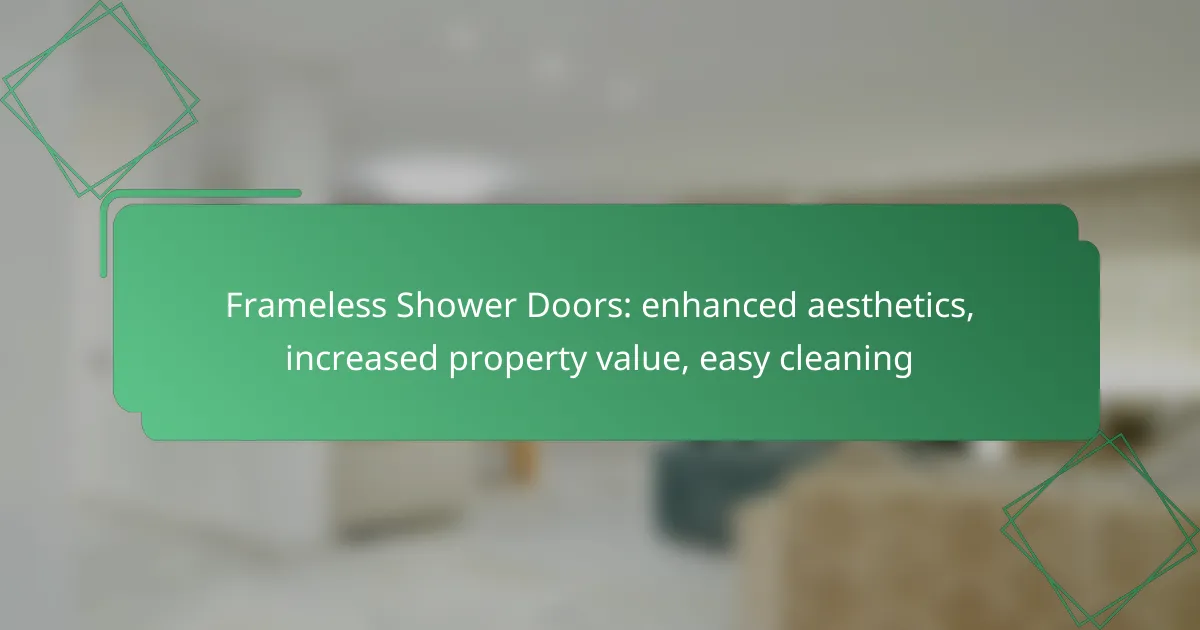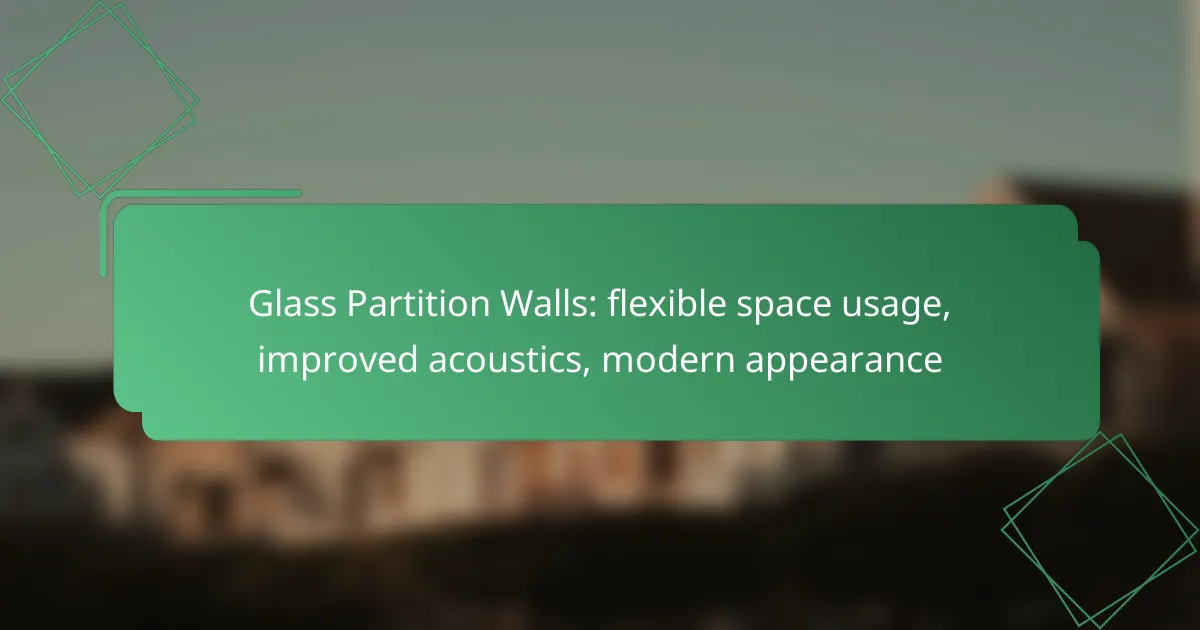Custom glass railings offer an elegant solution that enhances safety while providing a modern aesthetic. By creating a clear barrier that does not obstruct views, these railings ensure secure environments in both residential and commercial settings. Additionally, their transparent design maximizes natural light, making spaces feel brighter and more inviting.

How do custom glass railings improve safety in Toronto?
Custom glass railings enhance safety in Toronto by providing a clear barrier without obstructing views, ensuring that areas like balconies and staircases are secure. These railings are designed to withstand impacts and meet stringent safety standards, making them a reliable choice for both residential and commercial properties.
Tempered glass strength
Tempered glass is significantly stronger than regular glass, making it an ideal material for railings. It undergoes a heating and cooling process that increases its durability, allowing it to withstand high impacts and thermal stress. In the event of breakage, tempered glass shatters into small, blunt pieces, reducing the risk of injury.
For residential applications, using tempered glass that is at least 10 mm thick is common, providing a balance between safety and aesthetics. This thickness ensures that the railings can handle everyday wear and tear while maintaining a sleek appearance.
Secure mounting systems
Secure mounting systems are crucial for the stability of custom glass railings. These systems typically involve stainless steel brackets or channels that firmly anchor the glass panels to the structure. Proper installation is essential to ensure that the railings can withstand lateral forces, such as those from wind or accidental bumps.
When selecting a mounting system, consider options that allow for adjustments during installation. This flexibility can help achieve a perfect fit and enhance overall safety. Regular inspections of the mounting hardware are recommended to ensure long-term reliability.
Compliance with safety codes
In Toronto, custom glass railings must comply with local building codes and safety regulations, which are designed to protect residents and visitors. These codes specify requirements for height, load capacity, and materials used in railings to ensure they are safe for use.
Before installation, it’s important to consult with a professional who is familiar with the Ontario Building Code. This ensures that your glass railings not only meet safety standards but also enhance the overall design of your space while providing peace of mind.

What modern designs are available for glass railings in Canada?
In Canada, modern glass railing designs prioritize safety, aesthetics, and maximizing natural light. Popular options include frameless styles, glass panels with metal accents, and customizable finishes that cater to various architectural preferences.
Frameless glass railings
Frameless glass railings offer a sleek and unobstructed view, making them a popular choice for contemporary homes and commercial spaces. These railings consist of thick tempered glass panels secured with minimal hardware, enhancing safety while maintaining a modern look.
When considering frameless options, ensure that the glass thickness meets local building codes, typically ranging from 10 to 12 mm. Installation should be performed by professionals to guarantee structural integrity and compliance with safety standards.
Glass panel with metal accents
Glass railings with metal accents combine the elegance of glass with the durability of metal, creating a striking visual contrast. Common materials for accents include stainless steel or aluminum, which can be used for posts, handrails, or decorative elements.
This design not only enhances safety but also allows for a variety of styles, from industrial to modern. When selecting metal accents, consider finishes that resist corrosion, especially in regions with harsh weather conditions.
Customizable finishes
Customizable finishes for glass railings enable homeowners to tailor the look to their specific tastes and architectural styles. Options include tinted glass, frosted surfaces, or decorative patterns that can enhance privacy while still allowing light to pass through.
When choosing finishes, consider the overall design theme of your space and the level of maintenance required. For instance, textured finishes may require more frequent cleaning to maintain their appearance compared to clear glass options.

How do glass railings increase natural light in homes?
Glass railings enhance natural light in homes by allowing sunlight to pass through without obstruction. Their transparent nature creates an open and airy feel, making spaces appear brighter and more inviting.
Transparent materials
Glass railings are made from clear or frosted glass, which lets light flow freely into living areas. Unlike traditional railings made of wood or metal, glass does not block light, ensuring that rooms remain well-lit throughout the day.
When selecting glass for railings, consider options like tempered or laminated glass for safety and durability. These materials can withstand impacts while maintaining their transparency, providing both functionality and aesthetic appeal.
Open sightlines
Glass railings create unobstructed sightlines, allowing views to extend beyond barriers. This openness not only increases the perception of space but also encourages natural light to fill the area, enhancing the overall ambiance.
To maximize open sightlines, install glass railings in areas like balconies or staircases where visibility is crucial. Avoid bulky posts or frames that can disrupt the flow of light and views.
Enhanced outdoor views
By incorporating glass railings, homeowners can enjoy unobstructed views of their outdoor surroundings. This connection to nature not only brings in more light but also creates a serene atmosphere within the home.
Consider the placement of glass railings to frame desirable views, such as gardens or landscapes. This strategic positioning can significantly enhance the overall aesthetic and natural lighting of your living space.

What are the costs associated with custom glass railings in Ontario?
The costs for custom glass railings in Ontario can vary significantly based on materials, installation, and maintenance. Generally, homeowners can expect to invest several thousand dollars, depending on the specific design and features chosen.
Material costs
Material costs for custom glass railings typically range from CAD 100 to CAD 300 per linear foot. Factors influencing this price include the type of glass (tempered or laminated), thickness, and any additional features like decorative finishes or hardware. High-quality materials will enhance durability and safety but may increase overall expenses.
For instance, tempered glass is often preferred for its strength and safety, while laminated glass can offer additional soundproofing benefits. It’s essential to balance aesthetics and functionality when selecting materials.
Installation fees
Installation fees for custom glass railings in Ontario usually range from CAD 50 to CAD 150 per linear foot. This cost can vary based on the complexity of the installation, the experience of the contractor, and any additional structural modifications needed. Hiring a qualified professional is crucial to ensure compliance with local building codes and safety standards.
To avoid unexpected costs, obtain multiple quotes and check the contractor’s references. Ensure that the installation includes necessary permits and inspections to meet local regulations.
Maintenance expenses
Maintenance expenses for glass railings are generally low, but regular upkeep is necessary to maintain their appearance and safety. Typical maintenance costs may involve cleaning solutions and occasional repairs, which can total around CAD 100 to CAD 200 annually. Regular cleaning helps prevent buildup of dirt and grime, which can affect visibility and aesthetics.
Consider using a squeegee or soft cloth for cleaning to avoid scratching the glass. Additionally, inspect the railings periodically for any signs of wear or damage, addressing issues promptly to avoid higher repair costs later on.

What factors should be considered when choosing glass railings?
When selecting glass railings, it’s essential to consider building codes, design compatibility, and budget constraints. These factors ensure that the railings not only meet safety standards but also enhance the aesthetic appeal of your space while remaining within financial limits.
Building codes and regulations
Building codes and regulations vary by location and dictate the safety standards for glass railings. It’s crucial to check local guidelines to ensure compliance, as these may specify the type of glass, height requirements, and load-bearing capacities.
In many areas, tempered or laminated glass is required for safety. Additionally, some regions may have specific regulations regarding the spacing of vertical supports or the maximum height of railings, which can affect your design choices.
Design compatibility
Design compatibility is vital when choosing glass railings, as they should complement the overall aesthetic of your property. Consider the architectural style of your home or building; modern glass railings work well with contemporary designs, while more traditional settings may require a different approach.
It’s also important to think about the surrounding materials. For example, glass railings paired with wood or metal elements can create a striking contrast. Ensure that the colors and finishes of the railings harmonize with other design features to achieve a cohesive look.
Budget constraints
Budget constraints play a significant role in the selection of glass railings. The cost can vary widely based on the type of glass, framing materials, and installation complexity. Generally, you can expect to spend anywhere from a few hundred to several thousand dollars, depending on your choices.
To manage costs effectively, consider the total project budget, including materials and labor. It’s often beneficial to obtain multiple quotes from contractors and suppliers to find the best deal while ensuring quality and compliance with safety standards.

What are the maintenance requirements for glass railings?
Glass railings require regular upkeep to ensure safety and aesthetic appeal. Maintenance primarily involves cleaning, inspecting for damages, and considering weatherproofing options to prolong their lifespan.
Regular cleaning techniques
To maintain the clarity and shine of glass railings, regular cleaning is essential. Use a mixture of mild soap and water or a specialized glass cleaner, applying it with a soft cloth or sponge to avoid scratches.
For stubborn stains or hard water spots, a vinegar solution can be effective. Clean the railings at least once a month, or more frequently in areas with high dust or pollution levels.
Inspection for damages
Regular inspections for damages are crucial to ensure the safety of glass railings. Check for cracks, chips, or any signs of stress in the glass, as these can compromise structural integrity.
Conduct inspections every few months, especially after severe weather events. If any damage is found, consult a professional for repairs or replacements to avoid potential hazards.
Weatherproofing options
Weatherproofing glass railings can enhance durability and reduce maintenance needs. Consider applying a protective sealant designed for glass surfaces, which can help repel water and prevent staining.
In regions with harsh weather conditions, using tempered or laminated glass can provide additional strength and resistance to environmental factors. Regularly check the sealant and reapply as needed, typically every year, to ensure optimal protection.










